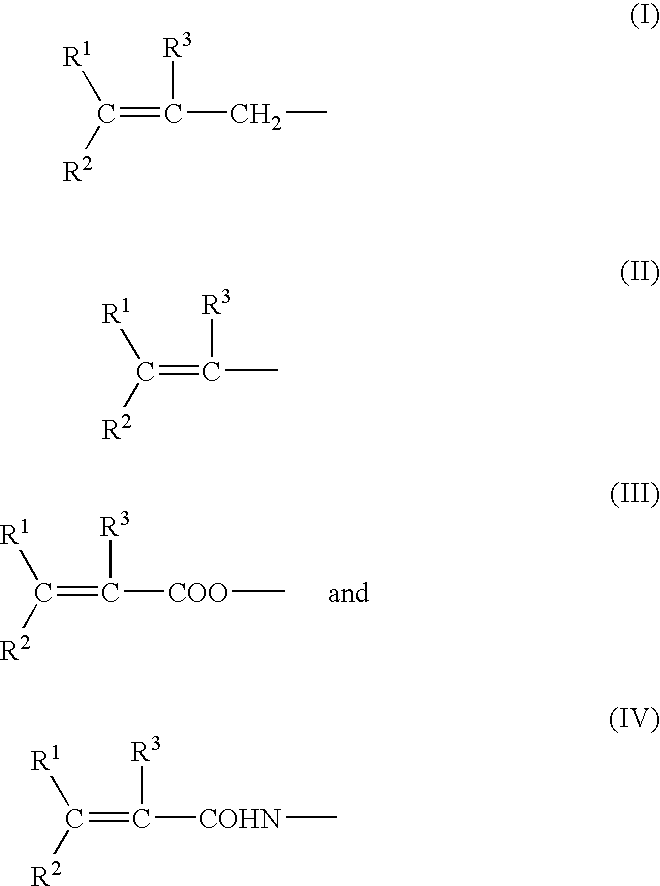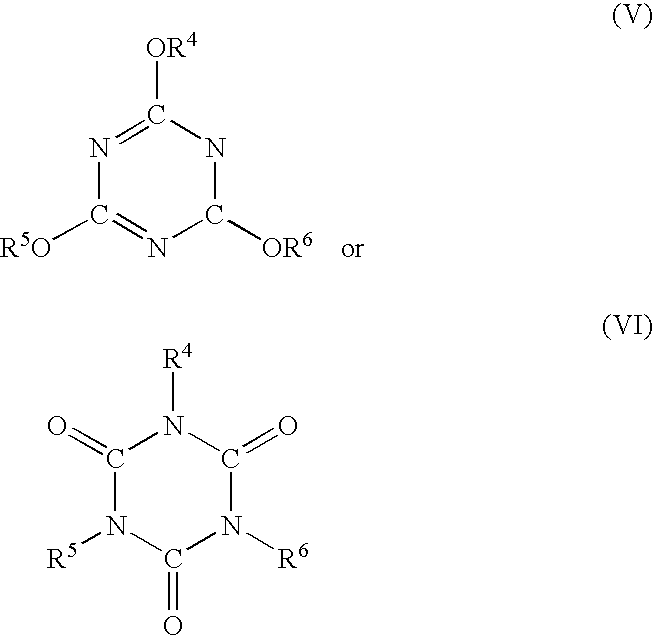Crosslinkable polyamide molding compounds and molded parts produced therewith
a technology of thermoplastic polyamide and molded parts, which is applied in the direction of layered products, synthetic resin layered products, chemistry apparatus and processes, etc., can solve the problems of inability to thermoplastically process formulations and unsuitable polyamide molded parts, and achieve the effect of improving mechanical, chemical and thermal properties
- Summary
- Abstract
- Description
- Claims
- Application Information
AI Technical Summary
Benefits of technology
Problems solved by technology
Method used
Image
Examples
example 1
[0045]Respectively 0, 2 or 3 wt. % TAIC (TAICROSS® from Degussa) was applied to the predried granules of the selected polyamide and tumbled in a mixer for 60 minutes. Samples measuring 60×10×1 mm and circular plates having a diameter of 70 mm and a thickness of 2 mm were produced by means of an Arburg 305-210 / 210-700 injection molding machine. For GRILAMID TR 90 (PA MACM12) the cylinder temperatures were in the range of 240° C. to 280° C. and for TR FE5577 (PA 6I / MXDI) in the range of 260° C. to 300° C. The test rods were used to make a qualitative assessment of the yellowing, the bubble formation, and the distortion. The circular plates which were produced with the aid of a polished tool were used to determine the transmission and the haze.
[0046]The samples were welded spray-dry in aluminum containers and irradiated with electrons in this form. The electron irradiation was carried out at Beta-GammaService in Bruchsal (Germany) on a 10 MEV electron accelerator installation having a ...
example 2
[0059]GRILAMID TR 90 was processed on a tool known per se for the injection molding of optical lenses for LEDs on a DEMAG Ergotech 35-120 injection molding machine having a 25 mm screw. The tool was an electrically heated quadruple tool having a cold channel and pin-point gates. The cylinder temperatures were between 240 and 280° C. The following two material variants were available:[0060]A) GRILAMID TR 90 natur with 3 wt. % TAIC (liquid beaten);[0061]B) GRILAMID TR 90 natur with 12 wt. % Master batch, consisting of 75% GRILAMID TR 90 natur and 25% TAIC GRILAMID TR 90 (PA MACM12) with liquid beaten TAIC (Variant A) has a moist-sticky consistency immediately after introducing the additive but can easily be drawn in and processed. Variant B in which TAIC is added in the form of a master batch also shows unproblematical dosing and processing behavior.
[0062]The LED lenses were measured for their 3D imaging accuracy in relation to the molding post. Extremely good values were found for bo...
examples 3 , 4 , 5
Examples 3, 4, 5, and 6
[0070]The transparent polyamides MACM12 (Grilamid TR 90) and PA MACMI / 12 (molar ratio: 81:19) were rolled into the compositions with TAIC given in Table 5 and processed on an ENGEL ES 330 / 80 injection molding machine at cylinder temperatures in the range of 240° C. to 300° C. to form cups. These cups had a height of 90 mm, an upper diameter of 70 mm, a lower diameter of 55 mm and a wall thickness of 1.5 mm. The cups were then welded spray dry in aluminum containers and irradiated with electrons in this form, as has already been described in Example 1. The total dose was 99 kGy.
[0071]
TABLE 5Compositions and results of Examples 3 to 6Example3456Composition and Tg of molding compoundsMACM12 [wt. %]97.029.129.40MACMI / 12 [wt. %]067.967.697.0TAIC [wt. %]3.03.03.03.0Glass transition temperature (Tg) [° C.]155180190200Result of fatigue temperature testNoncrosslinked molded body183192203206Temperature at which deformation of thecup occurs [° C.]Crosslinked molded body2...
PUM
| Property | Measurement | Unit |
|---|---|---|
| Temperature | aaaaa | aaaaa |
| Temperature | aaaaa | aaaaa |
| Temperature | aaaaa | aaaaa |
Abstract
Description
Claims
Application Information
 Login to View More
Login to View More - R&D
- Intellectual Property
- Life Sciences
- Materials
- Tech Scout
- Unparalleled Data Quality
- Higher Quality Content
- 60% Fewer Hallucinations
Browse by: Latest US Patents, China's latest patents, Technical Efficacy Thesaurus, Application Domain, Technology Topic, Popular Technical Reports.
© 2025 PatSnap. All rights reserved.Legal|Privacy policy|Modern Slavery Act Transparency Statement|Sitemap|About US| Contact US: help@patsnap.com


